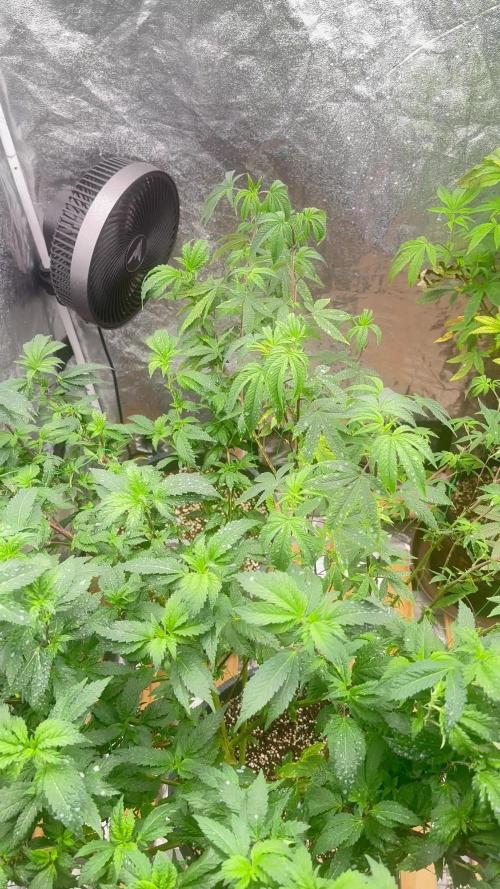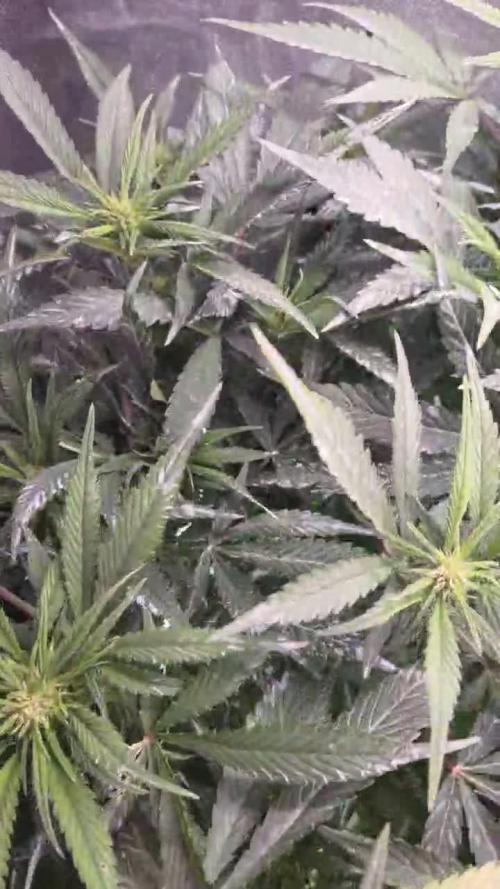The Grow Awards 2026 🏆 

































Likes
Comments
Share


@RakonGrow
Follow
Note :
+ jegliches Zubehör wird in der GermniationsWoche aufgelistet . Zeitraffer Videos folgen immer nachträglich.
+ videos werden so geschnitten das nur ein geschlossenes Zelt erscheint , ergo Fehlen paar reale Minuten (ca 1 Std) .
+ + leider ist die Halterung defekt und die Videos etwas schief . Vielleicht mach ich mich irgendwann mal daran und korrigiere das. Sorry
Day 43:
+ Höhe : 64cm
Es wächst und wächst :))
Day 44:
+ Höhe : 65cm
+ 2 Liter Flaschenwasser , kein Dünger .
+ + PH 6.5
+ Drain : PH 7.0
Höhe ist bei 63cm , das ist 3 cm mehr als die Vorgabe ausweisst :))
Day 45:
+ 66cm höhe.
+ 2 Liter Flaschenwasser
+ + Dünger für Blühte
+ + + Canna Terrar Flores (Achtung wirkt wie PH-)
+ + + Canna Boost
+ + + Cannazym
+ + + Greenhouse Feeding BioEnhancer als PH+
Jetzt säuft sie wie wilde , keine 24h und die 2Liter sind komplett wech . Mehr geht aber nicht in den Topf , ergo muss ich mir langsam mal überlegen ob ich Tropfbewässerung nutze .
Und es treten duch das nur Wasser extreme "Calzium" Probleme auf . Hihi , aber so hab ich mal das ganze auf Startsequenze gesetzt . Ich arbeite also noch daran diese Mischung aus BioBizz Light und Urgesteinmehl nach Schätzung zu meistern :)) Den Fakt ist , da ist viel zu viel Urgesteinmehl drinne , was auch die Vegiphase schon gezeigt hat.
Day 46:
+ 1.5 Liter Flaschenwasser
+ + Dünger für Blühte
+ + + Canna Terrar Flores (Achtung wirkt wie PH-)
+ + + Canna Boost
+ + + Cannazym
+ + + Greenhouse Feeding BioEnhancer als PH+
Day 47:
Draussen zu heiss , drinnen zu feucht ... Ja genau was ich nicht brauch lol ...
GoPro aus der Halterung gefallen :))
Day 48:
+ Höhe : 68cm
+ 2 Liter Flaschenwasser
+ + Dünger für Blühte
+ + + Canna Terrar Flores (Achtung wirkt wie PH-)
+ + + Canna Boost
+ + + Cannazym
+ + + Greenhouse Feeding BioEnhancer als PH+
Draussen zu heiss , drinnen naja ... Der Entfeuchter arbeitet weil ich sonst hier Tropenstimmung bekomme :)) Ein wenig Entlaubung .
Day 49:
+ Höhe : 68cm
+ 2 Liter Flaschenwasser
+ + Dünger für Blühte
+ + + Canna Terrar Flores (Achtung wirkt wie PH-)
+ + + Canna Boost
+ + + Cannazym
+ + + Greenhouse Feeding BioEnhancer als PH+
+ + + PH 5.8
+ + Drain PH 6.5
Läuft bei der Lady , sie trinkt , liebt das Licht (auch wenn die Spitze etwas zuviel bekommt , sie betet halt etwas ) , Mangelerscheinungen sind echt gering . Hat die heissen Tage (27° im Zelt bei 60%-57% ) hat sie super überstanden . Ich werde immer besser im Gießen . 75% von oben , 25% lass ich von unten aufsaugen .
Likes
6
Share


@weedelicious030
Follow
Alles ist super verlaufen und es gab keine Probleme. Die Royal Gorilla wachsen am schnellsten und sind sehr buschig.
Likes
19
Share


@Flavors
Follow
🌱 Week 16 Update (Veg)
The girls are still in veg and looking stronger than ever 💪🌿🍃. Canopy is wide, lush, and filling in beautifully 🌳✨ with steady growth 📈.
Thrip battle is almost won
Likes
17
Share


@Genji87
Follow
In week 3, I repotted the plants, including the automatics, into nice large 12.5-18 liter pots and, for the first time, watered each plant with 3 liters of water and added fertilizer from Biobizz (Root Juice, Grow, Heaven). After 3 weeks, the plants look very beautiful :)
I want to do some LST on the C99, but i want them to chill for some days after the repotting.
*Edit*New Pics
I just wait with the LST because my flowers were really stressed and had in fact some problems.
after i read some informations i just addet a little bit biobizz bloom & top for some iron etc,
I think the flowers look better in shape now, i dont know because they chilled or cause of the fertilizer adding.
LG
Likes
82
Share


@BigBadLion
Follow
Heeeey guys! 👋
Sorry for the very late update! I had so many things going on but now I can finally update the diary!
This is the last week before harvest and I kept an eye on my plants pretty much all the time! When I started to notice more amber trichomes were appearing I knew that my babies were finally ready! I just wanted a small amount of CBN, so probably I reached a good balance! Besides that I believe everything was quite relaxing and simple this week. Their smell was wonderful! I also trimmed by babies almost everyday, I kept removing the most ugly leaves to allow some of the lower buds to develop a little more this final week!
I stopped watering them 4 days before harvest and then I gave them one day of total darkness.
I hope you all enjoy the videos and photos!
Thanks!
Likes
13
Share


@GYOweed
Follow
This one is growing normally. Nice change. Need to transplant when u get room.
Likes
16
Share


@AestheticGenetics
Follow
4/15/25 This plant is blowing my freaking mind. Long stacked colas. Even the lower buds are plumping up like golf balls. This is an exceptional plant so far.
Shes starting to show the classic "sherbert" purple that ive noticed shows up with anything that has sunset sherbert in the lineage. Some of the leaves are starting to fade slightly and the purple is coming in.
The rs11 that this seed came from, produced the most from a single plant out of all plants ive grown and trained and kept that small. She yielded 3.5 ounces or a 1/4lb of top nugs from a plant that was only about 18 inches tall and vegged for 6 weeks before flip.
Once i start to clear out all of the fan leaves later on in flower, its just going to be buds running the length of the stems
4/18/25
I really believe this may be a keeper. She is absolutely stunning. Just everything is perfect. She has super long stacking of buds up and down the stems.
Im actually super stoked to see how she finishes up.
One of the craziest parts is that shes in a plastic 2 or 3 gallon pot and this plant is going to yield insane.
Likes
7
Share


@brapzky
Follow
Took some more microscope shots. Since I had 1x Medical Mass (1:1 THC:CBD), and 1x Pineapple Express with mostly THC, I wanted to maximize benefits from both. I was not sure when to have maximum amounts of both THC and CBD.
I figured I couldn't go entirely wrong if I waited until half of the trichomes had amber and the other half milky.
When is CBD AND THC the highest?
When to harvest THC:CBD 1:1 plants? I'd like to know that.
Likes
64
Share


@SmokingTiki
Follow
I started the week by selecting the 3 best plants to put them into their final 26l pots with some Dynomyco. I made the selection based on their sizes, shapes and roots. I increased the light output from 25% to 50% and started the week with 23h of light per day. After a few days I noticed what I think are light burns on every plants so I reduced the number of hours/day to 18h and it seems ok now. I checked the pH, not optimum but alright for soil and I always have this 7.0 with this soil and this pH meter (don't know if it works properly or not because it's always 7.0 in this soil, never 7.1 or 6.9).
The 3 plants grew a lot this week, it's one of my best growth rate so far so I'm very happy 😁 The Wedding Cheesecake is by far above the two others, it already developped 5 nodes so I topped it (first time it happens to me that soon). As usual with this soil, I think they have a bit of nitrogen toxicity but nothing critical.
Plants heights at the end of the week :
-------------------------------------------
Gorilla Cookies : 18.5cm
Purple Lemonade : 15cm
Wedding Cheesecake : 22cm
Processing
Likes
52
Share


@mr_black32
Follow
day70 : today I start the flush on GSC # 2
Day72 : all GSC(3) are in the flush phase
Day73 : after 7 and 10 days of flush, the first two plants (GSC#1 & Z.OG#1) are ready to be cut 👌
UPDATE : after a careful control of the grow box, I decided to start the flush phase on the other plants, except for 2 G.G. and the giant Z.OG 😎
Likes
145
Share


@biggreens420
Follow
She's stopped growing vertically and is chuncking up now took main nutes back down to 3 ml per litre she's smelling beautiful and is sticky as hell not much else to report will update some better pics when available thanks for reading happy growing guys
Likes
15
Share


@GrowsHimself
Follow
Happy with the amber percentage so chopped her down today 17/01/24. Some quick trimming of biggest fan leaves and then into dryer before it’s full dry trim.
Final dry weight after trim 116.8g
Processing
Likes
12
Share


@NorthEuropeanGrower
Follow
Weather is getting a bit better this week. Almost no rain anymore and much more sun comparing to last week. Blueberry Ghost OG and Kali AK still don't want to start flowering, but they slowed down from growing taller at least, so there are hope of they to start flowering soon (hopefully).
Likes
5
Share


@BudBrewerz
Follow
I'm very pleased with how this Pink lady is turning out. She packing very nice looking colas and the smaller buds are looking very good too and all of them are feeling very dense and sticky 😍🤤
I'm giving her another week or so... I started flushing a week ago. So guess we're good to go🙏
Likes
17
Share


@Greencrypto
Follow
Fattening up really nice every think smells how it should bubble gum really kicking up now they look very healthy I can’t complain thank you for stopping in leave a like I shall repay the favor some think not right please say 😅😁😎
Likes
36
Share


@Salokin
Follow
I think she has finally completed her stretch, it’s getting very shiny and sticky in the tent and the buds continue to grow nicely. She continues to be super thirsty and I think i will shorten the tank change intervals. From the 11 cuttings I took in flower around 9 made it and started to root quite nicely. However I think I was a bit to generous with the nutrients, which is corrected for the next week. A third net was installed in anticipation of the main colas getting to top heavy at a later stage. I also increased the canna boost by another 25 ml.
Likes
20
Share


@Ieiogrow94
Follow
Ecco i mutanti!!!
Finalmente ci siamo abbiamo tagliato la pianta mutante!!
Bellissima esperienza di coltivazione la bimba ha risposto bene ed una volta entrata in fioritura è stato un piacere portare a termine il cultivo!!
Grazie a tutti per il supporto!!!
Grazie a @00Seeds per la collaborazione ne vedremo delle belle!!!
❤️🔥💚





















